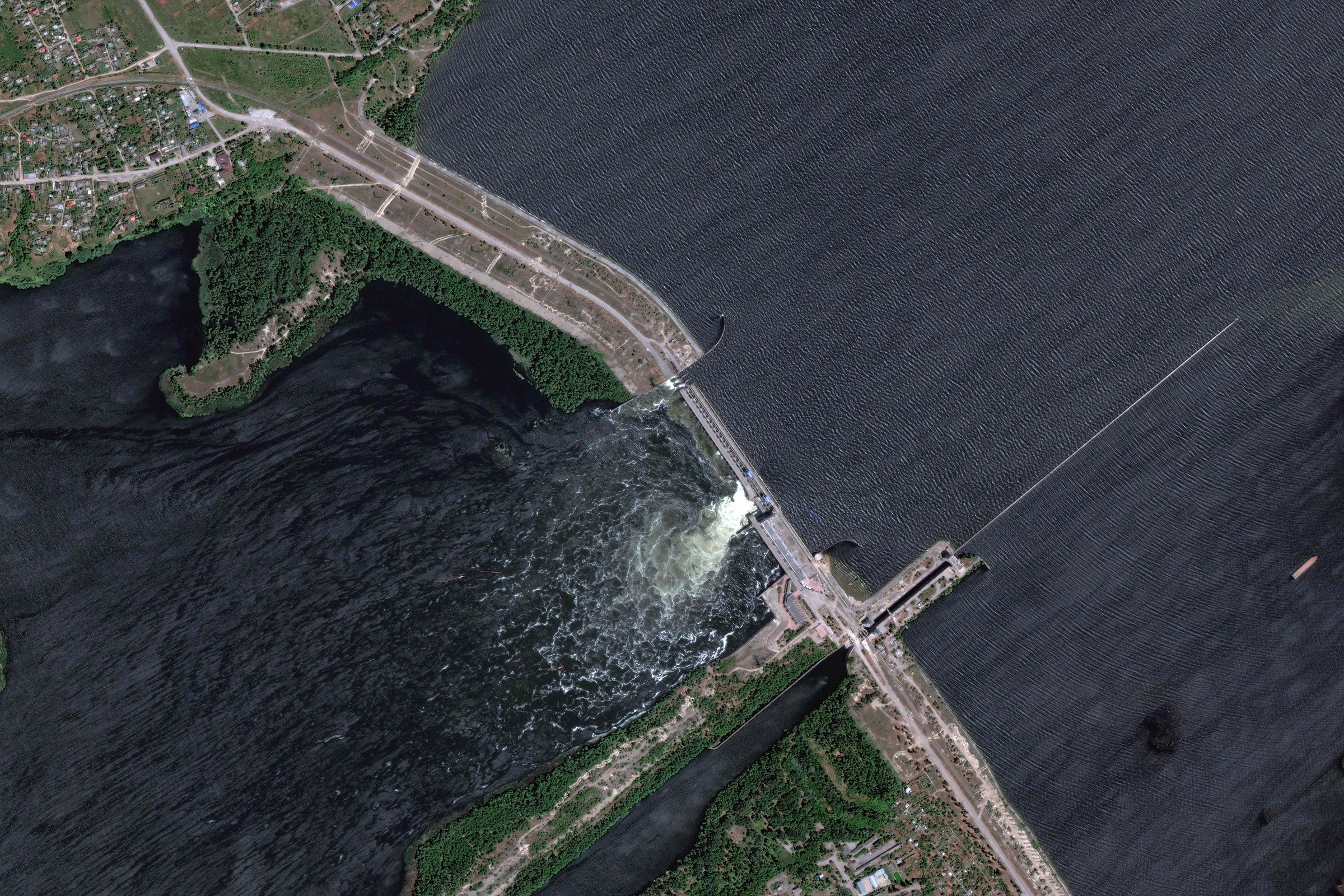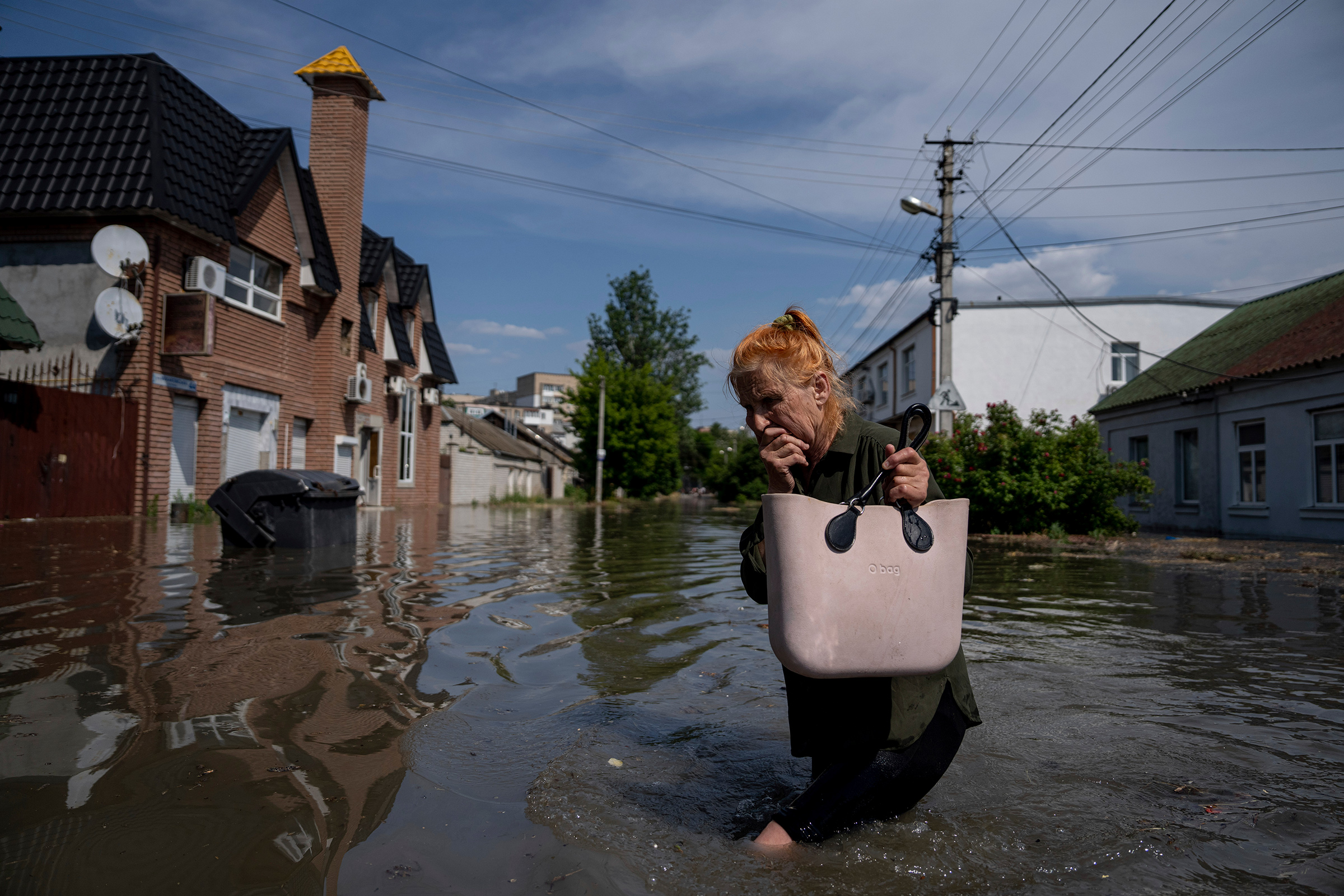The collapse of a huge dam in a Russian-occupied region of southern Ukraine has triggered flooding, with both Russia and Ukraine blaming each other for its strategic destruction.
The Nova Kakhovka dam, built in 1956 on the Dnipro River—18 mi. east of the city of Kherson—was breached as the result of an explosion Tuesday morning. Ukraine accuses Russian forces of blowing up the dam, which could also impact the nearby Zaporizhzhia nuclear power plant, while Russian officials say Ukrainian military strikes in the contested region caused the damage, according to the Associated Press.
The Russian-installed mayor of Kherson, Vladimir Leontyev, called the explosion a “terrorist act.” At present, it is unclear which nation is responsible or what either side would serve to gain from damaging the dam, which is said to have already been in a state of disrepair.
More from TIME
Ukrainian President Volodymyr Zelensky has coordinated an urgent meeting of the National Security Council in response to Tuesday’s attack. In October, Zelensky urged Western allies to warn Russia not to attack the dam, noting that it would cause “a large-scale disaster.” At the time, the leader suspected Russian forces had planted explosives in the dam.
Below, what to know about the attack, and more.
Why is the Nova Kakhovka dam significant?
The dam is 30 meters (98 ft.) in height and 3.2km (2 mi.) in width, containing a reservoir of around 18 cubic kilometers (4.3 cubic mi.) of water, about the same as the Great Salt Lake in Utah. As such, there are growing concerns that the sheer volume of water will severely damage nearby homes and low lying areas.

So far, evacuations have been ordered from at least 80 towns and villages, the Associated Press reported on Wednesday. Some 22,000 people live in areas at risk of flooding in Russian-controlled territory, and 16,000 in Ukrainian-controlled lands.
Nearly 12,000 people in Kherson are without electricity as a result of flooding.
Older people and individuals with disabilities are thought to be particularly at risk from the flooding. “It’s important to mention the demographics of the people being affected,” says Irina Kuznetsova, a professor at the University of Birmingham whose research focuses on forced displacement and migration.
She says that many of the people living in the region are people who found it too difficult to leave when the war had just broken out, putting them in a very vulnerable situation. “The intersection of age and disabilities with displacement is very dangerous.”
Polluted water supplies and wider environmental consequences are also anticipated as a result of the incident. Water levels rose by 11.5 ft. on Tuesday, and were rising by 2 to 3 inches every half-hour in low-lying areas, the Guardian reported.
Water from the dam’s reserve also supplies the Crimean peninsula—which Russia illegally annexed in 2014—and the Zaporizhzhia nuclear plant, raising concerns about safety and energy supply. The dam also helps power the local hydroelectric plant in Kakhovka.
‘No immediate risk’ to Zaporizhzhia nuclear plant
The Zaporizhzhia Nuclear Plant, Europe’s largest, shut down its six reactors months ago but still relies on water from the Dnipro River for cooling. The water reservoir was falling by two inches per hour on Tuesday, meaning that the supply of cooling water should last at least a few days. The U.N.’s International Atomic Energy Agency wrote in a statement that “there is no immediate risk to the safety of the plant.”
The IAEA’s director Rafael Mariano Grossi also said that there were additional water sources that officials could turn to, including a large cooling pond near the nuclear site that is above the height of the reservoir. The agency is hopeful that this pond may be able to cool reactors and diesel generators for several months, but this has not yet been confirmed.
Grossi has said that he will travel to the Zaporizhzhia plant next week.
Ukraine’s nuclear operator Energoatom echoed the IAEA’s assessment via Telegram, saying that the dam attack “could have negative consequences” for Zaporizhzhia but that the situation is “controllable.”

This is not the first time that the Zaporizhzhia plant has become a focal point of the war. In March 2022, fighting caused a fire to break out at the facility that was extinguished just a few hours later when Russia officially captured the plant from Ukraine. The nuclear plant is capable of producing up to 6,000 megawatts of electricity, powering up to 4 million homes.
However, there is a chance that nuclear waste from the Chernobyl disaster could be disturbed by the flooding, according to Vlad Mykhnenko, professor at Oxford University who studies the urban development of post-Soviet countries.
“There is potential that those deep reservoirs in the Dnipro River have quite a bit of nuclear waste,” Mykhnenko told TIME. “All those deposits could be moved around through wind and dust.”
What the attack means for Ukraine’s spring counteroffensive
The destruction of the dam has negative consequences for both Russia and Ukraine, with both countries racing to conduct evacuations of nearby residents. Mykhailo Podolyak, an advisor to Zelensky, has claimed that the destruction of the dam primarily benefits Russia, according to the Financial Times.
“The purpose is obvious: to create insurmountable obstacles in the way of the advancing Ukrainian armed forces,” said Podolyak.
David Helms, a retired American scientist who has been studying the dam since the war began, told the Associated Press that Russia has a history of attacking dams.
But the dam’s destruction also poses issues for Russia since the flooding will impact Russia’s defense forces in Kherson on the east of the Dnipro river.

Ukraine has long been expected by many experts to announce a counteroffensive soon to try and break the land bridge connecting mainland Russia with other Russian captured territories like the Zaporizhzhia and Kherson provinces, though the military has not officially revealed any information about such a plan. Breaking this land bridge would make it much more difficult for Russia to provide supplies and coordinate plans with captured Ukrainian territories. The flooding in the region would make that plan much more difficult to execute.
“Basically, it denies any ability for us to cross the river and move equipment in that area. Essentially, that’s why most likely Russia did it, particularly now,” Andriy Zagorodnyuk, a former Ukrainian defense minister, told the Financial Times.
However, some experts believe that the dam’s destruction won’t impact Ukraine’s plans significantly.
“There is not a lot of evidence that Ukraine was actually planning to cross the Dnipro because that would require a significant amount of ships and equipment,” Mykhnenko tells TIME. “So don’t think it will really significantly affect the Ukrainian offensive operations.”
Nevertheless, even if the dam’s destruction has little impact on Ukraine’s tactical plans, Mykhnenko expects the humanitarian impact to be severe.
“The river was providing drinking water to a lot of people… and that will obviously lead to drought and massive damage to farming in those areas, which are quite fertile for grain production,” Mykhnenko says. “I think we’ll probably have more damage than we expect from this disaster.”
This is a breaking news story. Check back for updates.
More Must-Reads from TIME
- Donald Trump Is TIME's 2024 Person of the Year
- Why We Chose Trump as Person of the Year
- Is Intermittent Fasting Good or Bad for You?
- The 100 Must-Read Books of 2024
- The 20 Best Christmas TV Episodes
- Column: If Optimism Feels Ridiculous Now, Try Hope
- The Future of Climate Action Is Trade Policy
- Merle Bombardieri Is Helping People Make the Baby Decision
Write to Armani Syed at armani.syed@time.com